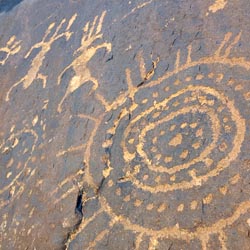


Hype:
The Little Black Mountain Petroglyph Site is comprised of over 500 glyphs made by members of several different American Indian groups over an 8,000 year period.
The site was used for several purposes including religious, ceremonial, and seasonal observations. Petroglyphs deliberately placed on boulders use the interplay of light and shadow to show seasonal changes. The glyphs that might indicate calendar observations include spirals, circles, bisected circles, plants, baskets, and constellations.
How are petroglyphs made? Three general methods were used: pecking, abrading, and scratching. These techniques removed the dark desert varnish exposing the natural rock's surface. Pecking was accomplished by striking a sharp rock directly on the boulder's surface or by using a hammer stone and pointed bone to produce a line of shallow indentations. Abrading was done simply by repeatedly rubbing or scratching the desert varnish, until there was enough contrast to produce the design.
What is desert varnish? Desert varnish is a product of an arid or semi-arid land. A little rain and lots of wind and sun are required. Desert varnish is a thin red to black coating composed of clay minerals, oxides, and hydroxides of manganese and/or iron. It is produced by the physiological activities of bacteria living on the rock's surface. The microorganisms extract manganese from the evironment, oxidize, and attach it onto rock surfaces. Desert varnish forms very slowly - it takes hundreds to thousands of years to form the very dark black color.
Little Black Mountain has been designated an ACEC to protect its significant archeological resources. Please treat these cultural resources with respect and help preserve them for future visitors and research.
For your own personal safety, to prevent erosion, and to protect the valuable fragile resources - PLEASE STAY ON THE GRAVEL TRAIL!
Be sure to look carefully! Erosion and lichen can appear to be petroglyphs at first glance.
Take nothing but pictures, leave nothign but footprints. For your own safety, please stay on the trail. Your cooperation is appreciated.
Trail Condition: Class 1 (Trail is either paved or gravel. Navigation skills are not needed because there is only one trail or because there are signs. Elevation gains are gradual or there are stairs.)
Time: 1 hour
Length: 0.65 miles round trip
Elevation Gain: Negligible
Fees: None
Recommended Ages:
 | 0-3 |
 | 4-11 |
 | 12-19 |
 | 20-49 |
 | 50-69 |
 | 70+ |
Recommended Months to Visit:
| Jan |
| Feb |
| Mar |
| Apr |
| May |
| Jun |
| Jul |
| Aug |
| Sep |
| Oct |
| Nov |
| Dec |
Links: BLM
Navigate to 36.982693, -113.502862.
Closest City or Region: St. George, Utah
Coordinates: 36.982693, -113.502862
By Jeremy Dye
30 minutes
I went down to St. Greorge for a conference and had a little extra time, so I dropped by the Little Black Mountain Petroglyphs and then over to Glitter Mountain before heading home.
Kolob Reservoir Primitive Camping
Hidden Canyon (Technical Route)
Flaming Gorge National Recreation Area
Little Black Mountain Petroglyph Site
St. George Dinosaur Discovery Site at Johnson Farm
Zion National Park Visitor Center